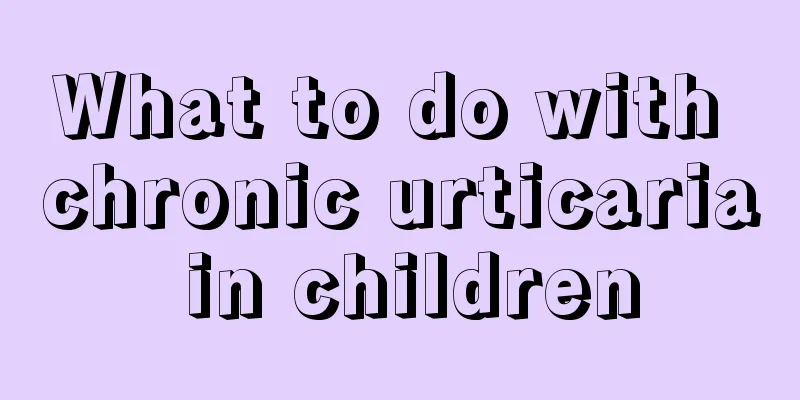What to do with chronic urticaria in children

|
Chronic urticaria is relatively common among children. This is mainly because children have relatively poor resistance and delicate skin, so they are easily infected and suffer from this skin disease. For children with chronic urticaria, they need to be taken to the hospital for treatment in time. In addition, they should also pay attention to diet and care in daily life. Below, we will introduce you to the relevant knowledge about chronic urticaria in children. 1. Treatment methods If urticaria in children continues to recur for more than six weeks, it becomes chronic urticaria. The cause of the disease is not necessarily related to food. Many other factors may cause chronic urticaria in children. Since the disease may recur, it is recommended not to use injections of drugs as the side effects of long-term use are greater. Instead, oral medications are more appropriate to maintain the concentration of drugs in the blood. However, most children with chronic urticaria will experience drowsiness, general weakness, etc. after using medications. Therefore, it is best for patients to cooperate with trusted doctors for a long time and not change doctors as soon as they feel that the medication is ineffective. 2. Dietary precautions Among food allergens, in addition to common allergenic foods such as fish, shrimp, crab, shellfish, eggs, bamboo shoots, etc., vegetables and fruits such as celery, coriander, peppers, strawberries, bananas, etc. can also induce urticaria. Foods such as mud snails, amaranth, chicken greens, and lettuce can also induce this disease. Because urticaria patients have poor resistance to the outside world or have not yet adapted to the environment, they are more likely to be allergic to milk, soybeans, peanuts, eggs, etc. If there are too many forbidden foods but they are needed by the human body on a daily basis, desensitization can be achieved by gradually increasing the amount consumed in small amounts. Eat more alkaline foods such as grapes, green tea, kelp, tomato Eggplant, sesame, cucumber, carrot, banana, apple, orange, radish, mung bean, pasta, etc. 3. Disease care 1. Do not let your child scratch the affected area with his hands to prevent itching; cold compresses can be used to relieve itching, or calamine lotion or zinc oxide lotion can be used to clean the skin; 2. Pay attention to balanced nutrition. Children should not eat too much high-protein food, eat less or no spicy food and seafood; 3. Pay attention to hygiene. It is very important to prevent mites at home. Prevent children from coming into contact with pollen and avoid activities under trees or in the grass. 4. Pay attention to weather changes and keep warm to avoid cold urticaria; children with urticaria should wear loose and breathable clothing to avoid irritation to the affected area; 5. Ensure adequate sleep to enhance the body's immunity. |
<<: Chronic urticaria in children
>>: What is the matter with children's urine
Recommend
Children's Sinusitis Massage
For children, since all medicines have certain si...
What causes vomiting in children?
Since children's body systems and organs are ...
What is the height and weight of a 25-month-old baby?
Babies are the apple of their parents' eyes. ...
Myopia in children
If your child tells you that he can't see obj...
Balanced method of routine blood test for newborns
Neonatal blood routine is an important indicator ...
At what age can children eat bird's nest?
Bird's nest is a very good tonic, which is ve...
Children with cold and stuffy nose
Colds and fevers are the most common diseases amo...
What to do if your newborn baby has diarrhea
A problem discovered, but when encountering this ...
Baby cold virus bacterial treatment
We all know that babies have small bodies, so the...
What to do if your baby has flat warts
Flat warts are a skin disease that is extremely h...
What should students eat to nourish their brains and make their children smarter?
The pressure faced by students is getting greater...
What should I do if my child has a stomachache? Teach you the correct way to do it!
If a child says that his stomach is uncomfortable...
What to do if pharyngitis causes fever
Pharyngitis mainly affects the mucous membrane of...
What to do if your five-year-old baby is grinding his teeth
Teeth grinding in a five-year-old baby is a big p...
How old is the best pillow for children?
When does the baby start using a pillow? Many mot...









